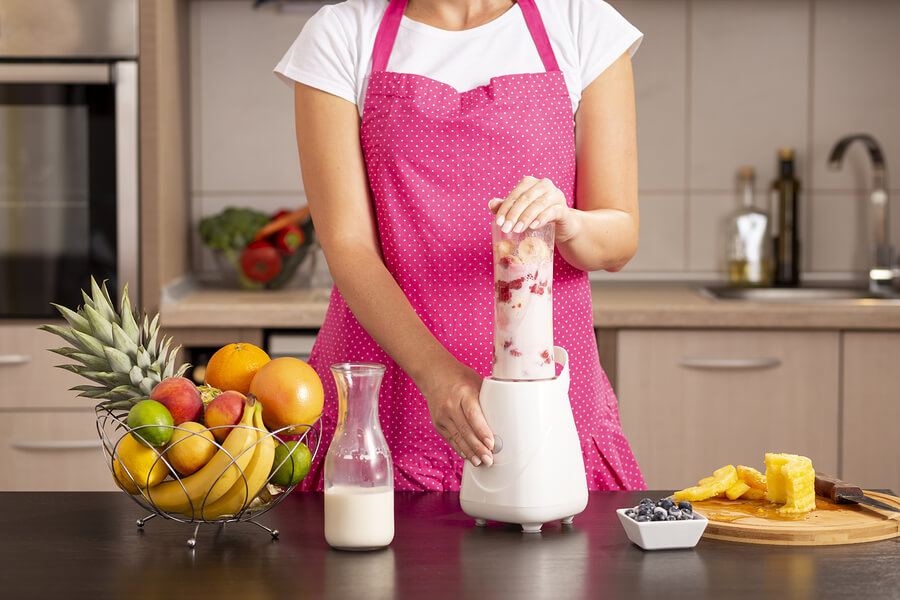A blender is a great accessory for both healthy beverages and special treats. It is important to do some research before you begin using one, however. You must work carefully to avoid problems. Glass blenders, for example, can break if you load it improperly. One common misconception surrounds the use of hot liquids. You must understand how hot liquids react in an enclosed space to avoid problems. When you understand a few simple tactics, you can successfully make many favorite hot beverages.
Pressure
When you place hot liquids into an enclosed space, the steam causes the pressure to build. If this happens you can expect a huge mess to follow. The top may blow off the top of the blender, allowing the liquid to propel all over the kitchen. Severe pressure can also cause a glass blender to break. You can avoid excessive pressure by venting the lid. Most blenders have a vent hole in the middle of lid you can remove when using hot liquids. Place a towel over this while blending your hot items so there is no splashing. The steam can easily escape around the edges of the towel.
Cool it Down
Read through the instructions for your blender to find out if it can tolerate hot liquids. You can often find temperature guidelines in the manual so you know how hot the items can be. Use a kitchen thermometer to check hot liquids before you pour them into the blender, as well. You can set your liquids out to cool or add an ice cube to cool it down faster. This method works well for mixtures you plan to eat or drink later. You may make a soup in your blender to store for a future meal, for example.
Adjust the Speed
It is always best to use a little extra caution when handling hot items in the kitchen. You can prevent the splashing of liquids by starting out slow, especially if you have solid items added into your recipe. Simply blend your beverage on slow speed first, then slowly increase the speed. This prevents the contents of the blender from propelling quickly to the top of the container. Most blenders have labels so you know what each speed is for. Start on the lowest speed until you become more familiar with each one.
Keep it Steady
Even with proper venting, the top of your blender can pop off. Be sure to hold the lid firmly in place while blending hot liquids. You can also place one hand on the container or the base of the blender. Lock the pitcher securely into the base . It can also help to research different brands to find the blender that works best for your dietary needs. Some blenders can handle a wider variety of foods and temperatures. A stable blender can make life much easier if you use it daily. Consider these options before you purchase a blender.
- Strength of the pitcher
- Temperature limits of the pitcher
- Stability (a sturdy base that locks the pitcher into it)
- A lid with a vent hole
- Size of the pitcher (a larger pitcher is nice since you can only fill halfway with hot liquids)

Limit the Amount
You must limit the amount of hot liquid in your blender. Fill the pitcher halfway when using hot liquids. This leaves some space in the container for the steam to move around until it can escape. It also lowers the pressure, lessening the risk of accidents. If you plan to make a large recipe, simply split it up into smaller portions, repeating the blending process several times. It takes less time to blend small portions than to clean up a mess from incorrect usage. If you have a large family or make extra portions, purchase a larger blender for more efficient use with hot liquids.
Safety First
If you have a blender that does not work well with hot liquids, you can suffer an injury. If a class pitcher shatters during use, shards of glass can end up all over your kitchen. You can also acquire cuts from the flying pieces of glass. Extremely hot liquids can burn you as they fly out of the blender, as well. The best way to prevent injuries is to read the user’s manual for your blender. Each blender has unique specifications and abilities.
It is convenient to have a blender that can handle hot liquids. You can use them for special beverages and soups. It takes much longer to mix items with a mixer. You also end up using more dishes and making a bigger mess. To avoid problems while blending hot liquids, read the directions for your blender. Remember to use minimal liquids, vent the lid, and hold the blender steady. You can enjoy many specialty recipes when you practice safe blending methods.


